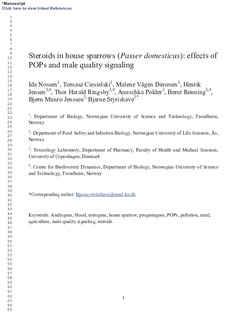| dc.contributor.author | Nossen, Ida | |
| dc.contributor.author | Ciesielski, Tomasz Maciej | |
| dc.contributor.author | Dimmen, Malene Vågen | |
| dc.contributor.author | Jensen, Henrik | |
| dc.contributor.author | Ringsby, Thor Harald | |
| dc.contributor.author | Polder, Anuschka | |
| dc.contributor.author | Rønning, Bernt | |
| dc.contributor.author | Jenssen, Bjørn Munro | |
| dc.contributor.author | Styrishave, Bjarne | |
| dc.date.accessioned | 2017-10-30T13:19:53Z | |
| dc.date.available | 2017-10-30T13:19:53Z | |
| dc.date.created | 2016-01-22T20:53:05Z | |
| dc.date.issued | 2016 | |
| dc.identifier.citation | Science of the Total Environment. 2016, 547 295-304. | nb_NO |
| dc.identifier.issn | 0048-9697 | |
| dc.identifier.uri | http://hdl.handle.net/11250/2462907 | |
| dc.description.abstract | At high trophic levels, environmental contaminants have been found to affect endocrinological processes. Less attention has been paid to species at lower trophic levels. The house sparrow (Passer domesticus) may be a useful model for investigating effects of POPs in mid-range trophic level species. In male house sparrows, ornamental traits involved in male quality signalling are important for female selection. These traits are governed by endocrinological systems, and POPs may therefore interfere with male quality signalling. The aim of the present study was to use the house sparrow as a mid-range trophic level model species to study the effects of environmental contaminants on endocrinology and male quality signalling. We analysed the levels of selected PCBs, PBDEs and OCPs and investigated the possible effects of these contaminants on circulating levels of steroid hormones (4 progestagens, 4 androgens and 3 estrogens) in male and female adult house sparrows from a population on the island Leka, Norway. Plasma samples were analysed for steroid hormones by GC–MS and liver samples were analysed for environmental contaminants by GC-ECD and GC-MS. In males, we also quantified ornament traits. It was hypothesised that POPs may have endocrine disrupting effects on the local house sparrow population and can thus interfere with the steroid hormone homeostasis. Among female house sparrows, bivariate correlations revealed negative relationships between POPs and estrogens. Among male sparrows, positive relationships between dihydrotestosterone levels and PCBs were observed. In males, positive relationships were also found between steroids and beak length, and between steroids and ornamental traits such as total badge size. This was confirmed by a significant OPLS model between beak length and steroids. Although sparrows are in the mid-range trophic levels, the present study indicates that POPs may affect steroid homeostasis in house sparrows, in particular for females. For males, circulating steroid levels appears to be more associated with biometric parameters related to ornamental traits. | nb_NO |
| dc.language.iso | eng | nb_NO |
| dc.publisher | Elsevier | nb_NO |
| dc.title | Steroids in house sparrows (Passer domesticus): Effects of POPs and male quality signalling | nb_NO |
| dc.type | Journal article | nb_NO |
| dc.description.version | submittedVersion | nb_NO |
| dc.source.pagenumber | 295-304 | nb_NO |
| dc.source.volume | 547 | nb_NO |
| dc.source.journal | Science of the Total Environment | nb_NO |
| dc.identifier.doi | 10.1016/j.scitotenv.2015.12.113 | |
| dc.identifier.cristin | 1320674 | |
| dc.relation.project | Norges forskningsråd: 223257 | nb_NO |
| dc.relation.project | Norges forskningsråd: 221956 | nb_NO |
| dc.relation.project | Norges forskningsråd: 204303 | nb_NO |
| dc.description.localcode | This is a submitted manuscript of an article published by Elsevier Ltd in Science of the Total Environment, 12 January 2016. | nb_NO |
| cristin.unitcode | 194,66,10,0 | |
| cristin.unitname | Institutt for biologi | |
| cristin.ispublished | true | |
| cristin.fulltext | preprint | |
| cristin.qualitycode | 2 | |
